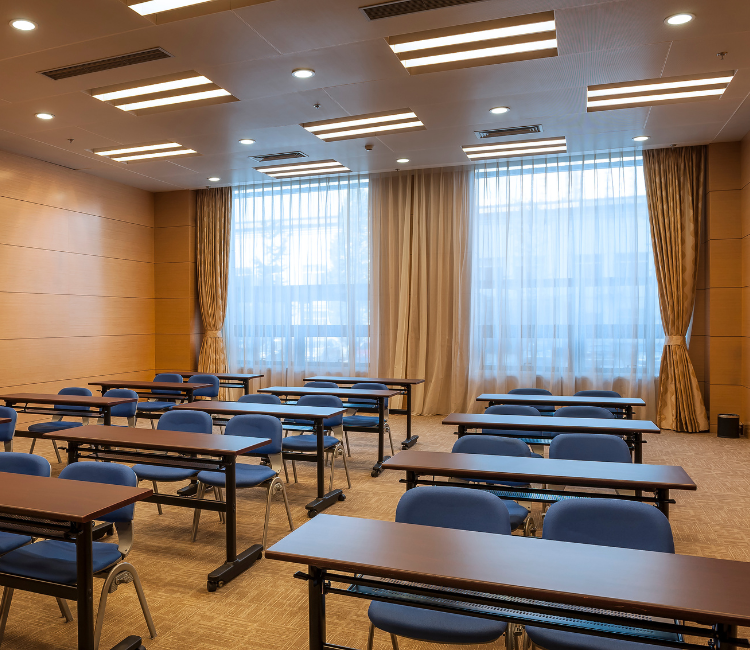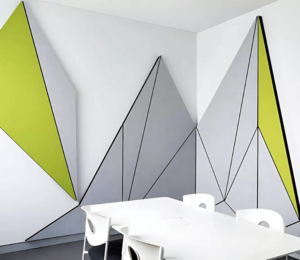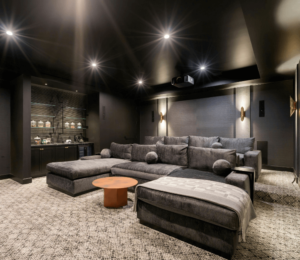The Silent Crisis in Classrooms: How Poor Acoustics Undermine Learning
Modern education faces an invisible challenge: noise. Studies show that poor classroom acoustics reduce speech comprehension by up to 25%, disproportionately affecting young learners, non-native speakers, and students with hearing impairments. At Gitco, we engineer acoustically optimized learning spaces that enhance focus, reduce teacher fatigue, and improve academic outcomes.
Table of Contents
Why School Acoustics Matter
The Impact of Poor Acoustics
- Students in noisy classrooms:
- Miss 30% of spoken words (ASA study)
- Show 10-15% lower test scores (Journal of Educational Psychology)
- Teachers experience:
- 3x higher vocal strain (NIDCD research)
- Increased stress from constant voice projection
Key Acoustic Challenges in Education
| Problem | Consequence |
|---|---|
| Reverberation (echo) | Muffled teacher instructions |
| HVAC/outdoor noise | Distracted students |
| Poor STI (Speech Transmission Index) | Reduced language development |
Gitco’s Education Acoustic Solutions
1. Classroom Acoustic Standards Compliance
We design to ANSI S12.60 and BB93 standards, ensuring:
- Reverberation time <0.6 seconds (ideal for speech clarity)
- Background noise <35 dB (quieter than a whisper)
2. Core Products for Schools
| Solution | Function | Placement |
|---|---|---|
| Ceiling Clouds | Absorb mid/high frequencies | Above teaching zones |
| Wall Panels | Reduce first reflections | Front/side walls |
| Bass Traps | Control low-frequency buildup | Room corners |
| Acoustic Partitions | Zone open-plan learning areas | Flexible layouts |
3. Specialized Spaces
- Auditoriums: Diffusion panels for even sound distribution
- Gymnasiums: Impact-resistant sound absorbers
- Music Rooms: Variable acoustics for different ensembles
The Gitco Advantage for Schools
✅ Evidence-Based Designs – Backed by psychoacoustic research
✅ Child-Safe Materials – Fire-rated, non-toxic, and durable
✅ Modular Systems – Easy retrofitting in existing buildings
✅ Saudi-Specific Expertise – Solutions for regional architecture
Education Acoustics – Frequently Asked Questions
Creating optimal learning environments goes beyond just desks and whiteboards. The acoustic design of educational spaces significantly impacts students’ ability to learn and teachers’ ability to instruct effectively. Here’s what people search for regarding education acoustics, and how Gitco can help create sound environments for success.
Frequently Asked Questions:
- What is “education acoustics”?
- Education acoustics refers to the study and application of controlling sound within learning spaces like classrooms, lecture halls, libraries, and gymnasiums to enhance learning and teaching.
- Why is good acoustics important in educational settings?
- Good acoustics improves speech intelligibility, reduces distractions, enhances focus and concentration, minimizes vocal strain for teachers, and supports the well-being of both students and staff.
- How does poor acoustics affect learning?
- Poor acoustics can lead to reduced comprehension, difficulty in understanding instructions, impaired memory retention, increased stress, and behavioral issues in students.
- What are the key acoustic challenges in classrooms?
- Common challenges include excessive background noise from within and outside the classroom, high reverberation times, and poor signal-to-noise ratio (teacher’s voice vs. background noise).
- What are classroom acoustics standards?
- Standards like ANSI S12.60 and Building Bulletin 93 (BB93) provide guidelines for maximum background noise levels and reverberation times in classrooms to ensure effective learning environments.
- What is reverberation time (RT) and why is it important in classrooms?
- Reverberation time is the time it takes for a sound to decay in a room. Short RTs are crucial for speech intelligibility in classrooms.
- What is background noise, and what are common sources in schools?
- Background noise is unwanted sound in a learning space. Common sources include HVAC systems, computer equipment, student chatter, hallway noise, and external traffic.
- What is signal-to-noise ratio (SNR), and why is it critical for learning?
- SNR is the difference between the level of the teacher’s voice and the background noise. A positive SNR (teacher louder than noise) is essential for students to clearly hear and understand instructions.
- How can acoustic treatment improve classroom acoustics?
- Acoustic panels, ceiling tiles, carpets, and other sound-absorbing materials can reduce reverberation and absorb background noise, improving speech clarity.
- What are acoustic panels, and where are they typically placed in a classroom?
- Acoustic panels are sound-absorbing materials installed on walls and ceilings to reduce sound reflections and reverberation.
- Are acoustic ceiling tiles effective for improving classroom acoustics?
- Yes, acoustic ceiling tiles with high Noise Reduction Coefficient (NRC) values can significantly absorb sound and reduce reverberation in classrooms.
- Can the layout and design of a classroom affect its acoustics?
- Yes, room shape, size, and the placement of furniture and reflective surfaces can impact sound quality. Buffer zones and strategic arrangements can help.
- How does noise impact students with special educational needs?
- Students with hearing impairments, learning disabilities, or autism are particularly sensitive to poor acoustics, which can increase anxiety, stress, and hinder their ability to learn.
- Do good acoustics benefit teachers as well as students?
- Absolutely. Reduced noise levels and better acoustics minimize vocal strain for teachers, leading to improved well-being and more effective instruction.
- What are the long-term effects of poor acoustics in educational environments?
- Chronic exposure to poor acoustics can contribute to stress, fatigue, hearing problems, and decreased academic performance for both students and teachers.
- How can Gitco help improve the acoustics of educational spaces?
- Gitco offers a range of high-performance acoustic materials, including panels, ceiling solutions, and sound barriers, along with expert consultation and design advice.
- What are some cost-effective ways to improve classroom acoustics?
- Simple measures include using soft materials like rugs and curtains, arranging desks to reduce direct sound paths, and adding fabric bulletin boards.
- How can technology be used to manage noise in classrooms?
- Noise-canceling headphones for focused work, sound field amplification systems to distribute the teacher’s voice evenly, and sound masking systems can be beneficial.
- What are the key considerations for acoustics in different educational spaces like libraries and gymnasiums?
- Libraries require low background noise and minimal distractions, while gymnasiums need to manage high noise levels and reverberation for safety and communication.
- How can schools get started with Gitco to engineer better learning environments through acoustics?
- Contact our team for an acoustic assessment of your educational spaces. We can provide tailored solutions and material recommendations to create optimal sound environments for learning and teaching.
Transform Your Learning Spaces Today
Every child deserves to hear their teacher clearly. Let Gitco turn your classrooms into acoustically optimized hubs of learning.
📞 Contact our education acoustics team for a free consultation.



